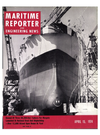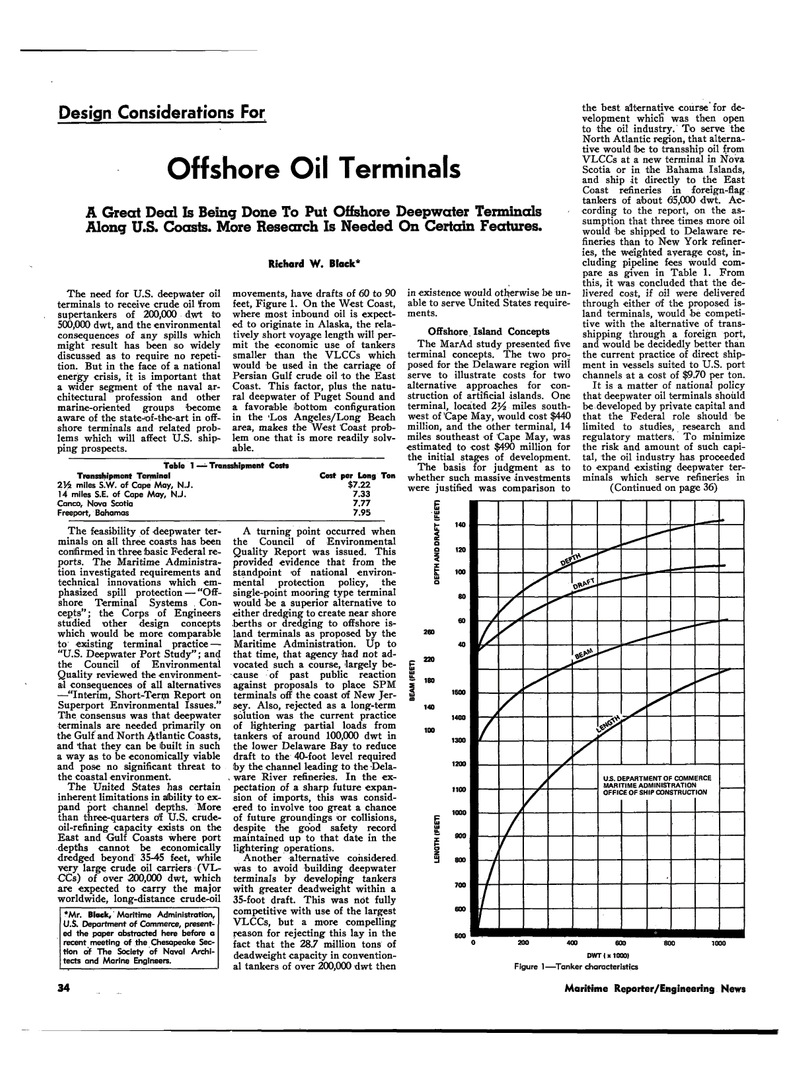
Page 31: of Maritime Reporter Magazine (April 15, 1974)
Read this page in Pdf, Flash or Html5 edition of April 15, 1974 Maritime Reporter Magazine
Design Considerations For
Offshore Oil Terminals
A Great Deal Is Being Done To Put Offshore Deepwater Terminals
Along U.S. Coasts. More Research Is Needed On Certain Features.
The need for U.S. deepwater oil terminals to receive crude oil from supertankers of 200,000 dwt to 500,000 dwt, and the environmental consequences of any spills which might result has been so widely discussed as to require no repeti- tion. But in the face of a national energy crisis, it is important that a wider segment of the naval ar- chitectural profession and other marine-oriented groups become aware of the state-of-the-art in off- shore terminals and related prob- lems which will affect U.S. ship- ping prospects.
Richard W. Black* movements, have drafts of 60 to 90 feet, Figure 1. On the West Coast, where most inbound oil is expect- ed to originate in Alaska, the rela- tively short voyage length will per- mit the economic use of tankers smaller than the VLCCs which would be used in the carriage of
Persian Gulf crude oil to the East
Coast. This factor, plus the natu- ral deepwater of Puget Sound and a favorable bottom configuration in the 'Los Angeles/Long Beach area, makes the West Coast prob- lem one that is more readily solv- able.
Table 1 —- Transshipment Costs
Transshipment Terminal 214 miles S.W. of Cape May, N.J. 14 miles S.E. of Cape May, NJ.
Canco, Nova Scotia
Freeport, Bahamas
Cost per Long Ton $7.22 7.33 7.77 7.95
The feasibility of deepwater ter- minals on all three coasts has been confirmed in three basic Federal re- ports. The Maritime Administra- tion investigated requirements and technical innovations which em- phasized spill protection — "Off- shore Terminal Systems Con- cepts" ; the Corps of Engineers studied 'other design concepts which would be more comparable to existing terminal practice — "U.S. Deepwater Port Study"; and the Council of Environmental
Quality reviewed the environment- al consequences of all alternatives —"Interim, Short-Term Report on
Superport Environmental Issues."
The consensus was that deepwater terminals are needed primarily on the Gulf and North Atlantic Coasts, and that they can be ibuilt in such a way as to be economically viable and pose no significant threat to the coastal environment.
The United States has certain inherent limitations in ability to ex- pand port channel depths. More than three-quarters of U.S. crude- oil-refining capacity exists on the
East and Gulf Coasts where port depths cannot be economically dredged beyond 35-45 feet, while very large crude oil carriers (VL-
CCs) of over 200,(XX) dwt, which are expected to carry the major worldwide, long-distance crude-oil *Mr. Black,' Maritime Administration,
U.S. Department of Commerce, present- ed the paper abstracted here before a recent meeting of the Chesapeake Sec- tion o'f The Society of Naval Archi- tects and Marine Engineers. in existence would otherwise be un- able to serve United States require- ments.
Offshore Island Concepts
The MarAd study presented five terminal concepts. The two pro- posed for the Delaware region will serve to illustrate costs for two alternative approaches for con- struction of artificial islands. One terminal, located 2}4 miles south- west of 'Cape May, would cost $440 million, and the other terminal, 14 miles southeast of Cape May, was estimated to cost $490 million for the initial stages of development.
The basis for judgment as to whether such massive investments were justified was comparison to the best alternative course for de- velopment whicfi was then open to the oil industry. To serve the
North Atlantic region, that alterna- tive would Ibe to transship oil from
VLCCs at a new terminal in Nova
Scotia or in the Bahama Islands, and ship it directly to the East
Coast refineries in foreign-flag tankers of about 6'5,000 dwt. Ac- cording to the report, on the as- sumption that three times more oil would :be shipped to Delaware re- fineries than to New York refiner- ies, the weighted average cost, in- cluding pipeline fees would com- pare as given in Table 1. From this, it was concluded that the de- livered cost, if oil were delivered through either o'f the proposed is- land terminals, would .be competi- tive with the alternative of trans- shipping through a foreign port, and would be decidedly better than the current practice of direct ship- ment in vessels suited to U.S. port channels at a cost of $9.70 per ton.
It is a matter of national policy that deepwater oil terminals should be developed by private capital and that the Federal role should be limited to studies, research and regulatory matters. To minimize the risk and amount of such capi- tal, the oil industry has proceeded to expand existing deepwater ter- minals which serve refineries in (Continued on page 36)
A turning point occurred when the Council of Environmental
Quality Report was issued. This provided evidence that from the standpoint of national environ- mental protection policy, the single-point mooring type terminal would be a superior alternative to either dredging to create near shore berths or dredging to offshore is- land terminals as proposed by the
Maritime Administration. Up to that time, that agency had not ad- vocated such a course, largely be- cause of past public reaction against proposals to place SPM terminals off the coast o'f New Jer- sey. Also, rejected as a long-term solution was the current practice of lightering partial loads from tankers of around 100,000 dwt in the lower Delaware Bay to reduce draft to the 40-foot level required :by the channel leading to the Dela- , ware River refineries. In the ex- pectation of a sharp future expan- sion of imports, this was consid- ered to involve too great a chance of future groundings or collisions, despite the good safety record maintained up to that date in the lightering operations.
Another alternative considered was to avoid building deepwater terminals by developing tankers with greater deadweight within a 35-foot draft. This was not fully competitive with use of the largest
VLCCs, but a more compelling reason for rejecting this lay in the fact that the 28.7 million tons of deadweight capacity in convention- al tankers of over 200,000 dwt then ts 111
U. t <
DC a a \ x fc 260 — 220 — 180 S < 140 too 140 120 100 60 40 1500 1400 1300 1200 1100 1000 r 900 800 700
GOO 600 \ f\
US. DEPARTMENT OF COMMERCE
MARITIME ADMINISTRATION
OFFIC IE OF SH IP CON STRUCT ION 200 400 800 1000
DWT (x 1000)
Figure 1—Tanker characteristics 34 Maritime Reporter/Engineering News

 30
30

 32
32
